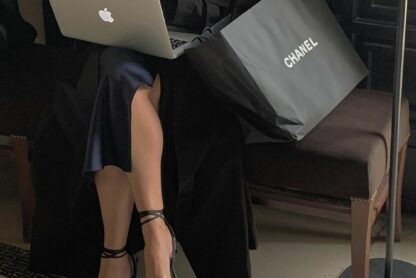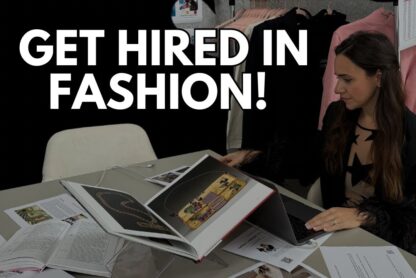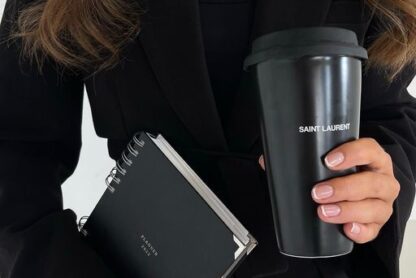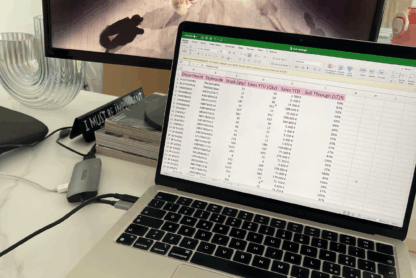Have you always loved dressing yourself up and giving style advice to other people? Are you constantly up to date with the latest trends and love studying different looks? Maybe you imagine dressing celebrities, or working at your favorite fashion magazine styling models for photoshoots? If this sounds like you, then a career as a fashion stylist may be perfect for you!
But how exactly can you get one of the most sought-after careers in the fashion industry and become a stylist? You may think that you need to hold a fashion degree or have many years of experience, because how can you style celebrities and models for the top fashion magazines if you are just a beginner?
You know how at Glam Observer we always try to show you that you can get a job in fashion in any field even if you didn’t study fashion or don’t have any experience. You also know how we love analyzing careers in the fashion industry to give you some tips from the inside and to help you to find the right fashion career path. That’s why today, I would like to talk to you about the fascinating career of a stylist and show you how to get a job as one.
How to Get A Job As A Stylist
Who is a fashion stylist?
When you see those beautiful outfits in your favorite magazines, advertising campaigns, fashion shows and on the red carpet, there is a person behind what people/models are wearing and that person is the stylist.
A stylist works together with a photographer, hair stylist, makeup artist, editor, art director, and client to create a look for fashion campaigns, fashion shows or websites (if you are an e-commerce stylist) and dress models and celebrities for photoshoots and events. The goal of the stylist is to make the person, the outfit or a specific product look as fashionable, flattering and harmonious as possible.
There are stylists who work at a fashion company or magazine, while others prefer to freelance as digital stylists, or work for themselves with their own client database. Hence, their responsibilities can differ.
There are different types of stylists: editorial stylist, personal stylist, celebrity stylist, wardrobe stylist, commercial stylist, among others.
An editorial stylist creates imagery for print or digital magazines, working on what in fashion are called editorials. Fashion magazines work with freelance stylists and fashion editors in-house. Fashion editors in many cases are more stylists than writers, especially when they work at glossy magazines such as Vogue. So if you are considering a career as a stylist, you should know that fashion editors who work at fashion magazines are responsible for the look and the mood of the shoot, so they choose the photographer, the clothing, the location, and the models.
A stylist creates a look based on 3 things: the models, the location and the readers of that specific magazine. They have to build a story with the model, trying to give her/him something that could appear true, close to the model’s life. You also need to consider your location, and know who your reader is in order to understand what the latter will expect from the service to best fit his/her expectations. To sum up, everything needs to be harmonious.
Sometimes, fashion editors have similar roles. Stylists create mood boards for each shooting so that they (or their assistants) will know what to request from brands’ pr . Stylists take inspiration for their shootings from different things: books, fashion websites , fashion shows, past shootings but also movies and art.
Working at a fashion magazine is just one of the options that stylists can explore.
There are also stylists who work at fashion brands (Gucci, Burberry, Dior..) and multi-brand companies such as Net-a-Porter, MyTheresa, etc. as freelancers or as employers. Stylists who work at fashion brands and companies, produce what is defined as commercial styling that has the goal to sell a specific product of the collection.- Think of the advertising pages you see in a magazine, or the content you see on social media, the brand websites or the fashion shows: stylists help to make the products appealing and create outfits that sell.
A stylist can also work one-on-one with a specific client. The role of a personal stylist involves working with a person to build their personal style and brand by choosing flattering looks. A personal stylist thus analyzes the existing wardrobe of their client, and selects looks that suit their body shape, lifestyle, their job, where they live, who they have to meet with, what events they attend as well as their daily routines and special occasions.
This role is similar to the one of a celebrity stylist. The difference is that contrary to a personal stylist, a celebrity stylist works with high-profile clients and collaborates with brands and the press. A celebrity stylist curates looks for everything from everyday outfits to red carpet events. In this interview I conducted with Holly Ounstead who worked with stars such as Leona Lewis, Little Mix and Kimberly Wyatt, as well as magazines such as Marie Claire and Glamour, she shared about her journey as a stylist and explained what the process of styling looks like when working with her clients.
A stylist’s responsibilities can change depending on the client, the brand and the specific project they are working for.
Here are the most common tasks a stylist is usually assigned:
- Attend runway shows, brand showrooms, and various fashion industry events to keep in touch with the latest trends;
- Study and look at the fashion history to create outfits taking into account the dominating style of a given time period:
- Follow the current trends;
- Source clothing from a worldwide range of brands;
- Consult team members involved in the photoshoot or runway process: models, photographers, hair stylists, makeup artists, costume designers, brand creative directors, and art directors, magazine editors, and film and TV directors…the list can go on;
- Work closely with the client to capture his personal visual aesthetic, understand his body type, taste and what colors, shapes and clothes would look best on him;
- Assist clothing buyers for major retail chains.
What Qualifications Do You Need To Be A Stylist?
In order to become a stylist, a degree in styling is not the only thing you can take. I once interviewed Camila Rizzolo during a photoshoot in Milan who works as a freelance fashion stylist at Vogue Japan. When I asked her how someone becomes a fashion stylist, even though she studied Fashion Styling, she shared from her personal experience that “You do not become a stylist, not even with a degree in Fashion Styling or any other course either. It is a passion, something innate that you have always carried inside. A fashion course is something that can complete your passion, it can make it more concrete, it can refine certain techniques and deepen certain knowledge, but it all starts with you.”
If you don’t want to take a fashion styling degree or you already graduated in something else, it’s okay. You can still become a stylist.
Educate yourself on the different designers, the fabrics and the history of fashion. Stay updated on trends, watch fashion shows and read the reviews to analyze how the outfits are styled and draw inspiration from them. Follow social media accounts of fashion brands to study the looks shot during campaigns, and use Pinterest to draw infinite inspiration. Finally, look at the different celebrities and red carpets and study their individual looks. You get it: there is an incredible amount of platforms to do your research, so that you can both learn about the styling technique and get many ideas that can inspire you to create your own outfits that you can use in your portfolio.
The best way to become a stylist after all is with experience. You need to start by assisting other stylists, no matter what degree you have.
Skills Needed To Be A Fashion Stylist
Being a stylist is a glamorous career, but it is also very demanding, as it requires a skill set that involves constant research, creativity and inspiration.
Communication skills and flexibility
These are one of the most important skills to have in every fashion job, and styling is no exception. You need communication skills to be able to ask your clients the right questions, listen to their answers to understand their taste and preferences while communicating your personal vision to them, with the goal to create a stylish outfit that makes both you and your client happy. Style is subjective; what you think looks stylish won’t look the same to the other person. Not every client will be easy to work with, as it may be more difficult to find clothes that satisfy your client, which is why you need to be flexible and be ready to adjust to the client’s needs.
An eye for detail
Working as a stylist demands having an artistic eye and stylist skills to know what colors go together and what looks harmonious. You also need to know your client’s body type and see what parts to accentuate. In addition, you need to make sure the outfit looks cohesive, that there are no missing details or – on the contrary – any unnecessary pieces.
Networking
As a fashion stylist, you must have a wealthy client base and an extensive network of designers, PRs, photographers, art directors, models. Even when you’ll be just an assistant, try to get in touch with everyone you’ll work with at every single photoshoot: from the photographer to the model, other stylists on set, or even fellow assistants. Word of mouth is the best way to land a job in fashion so you never know if any of these contacts can recommend you for your next styling opportunity.
How much does a fashion stylist make?
The income of a fashion stylist depends – like in any occupation – on the experience level and the country where you work. Nonetheless, it can be useful to have an idea about the average salaries to know the current reality of the job market.
A stylist makes, on average, £24,000 per year in London, $50,000 in New York, €26,400 in Paris and €26,944 in Milan. Keep in mind that this is just approximate data, and that your salary will depend on what type of styling you do, your experience level and whether you are working at a company or freelancing.
How to get a job as a stylist?
Styling internships and assistant stylists
The best way to start your fashion career as a stylist is to look for styling internships or even better – become a stylist’s assistant. An assistant stylist supports stylists with packing and unpacking clothes and accessories for the shootings, they arrange deliveries and communicate with the brand’s PR to request the products or looks that the stylist asked for the specific photoshoot. An assistant stylist also helps on set with the most practical tasks, from ironing the garments to organizing the looks on racks and preparing everything to be sent back to brands at the end of the shooting.
How can you get a styling internship or become a stylist assistant? You can look for styling internships online or even better, email stylists you find on Instagram, asking if you can assist with anything even for a couple of hours per week or just for one shooting. If you want to work for a magazine or a brand, you can send a cold-email to them as well to ask if there is an internship available. Everyone can need an extra hand, so take a shot, be productive and offer your help.
Fashion week can also be a good opportunity. Of course, you may not expect to be given this exact responsibility because it demands more experience, however, you could ask to assist experienced stylists. You can even be assigned to dress the models, which is a common volunteer job during fashion week. Even though it doesn’t involve styling, it is a good first start to learning to put together an outfit so that it looks cohesive.
Build your portfolio/lookbook
You might be wondering what exactly a lookbook is? If you’re unfamiliar with the term, a lookbook (aka a portfolio) is a collection of photos that showcase your work as a stylist. It’s okay if you have never worked as a stylist before; your portfolio can include photos of the outfits you styled for yourself, family or friends. A well-styled outfit is a well-styled outfit – no matter your experience level. Having a portfolio is important because it will allow potential clients or companies to see your best work, and it can kick-start your stylist career building a client base.
To conclude, I want to leave you with some inspiration from one of the most popular Hollywood celebrity stylists Karla Welch, who dresses Olivia Wilde, Justin Bieber and Karlie Kloss, among others. She said that the best way to break into the styling world is by interning and assisting as much as possible. “Go and see fashion and photography-related movies, read style books and be super interested in what’s going on in culture. Make it your mission to work harder than anyone else. You have to know that there’s sacrifice before there’s any glory.”
We hope you feel more confident by now about building your career as a fashion stylist. If it sounds like a dream career, start practicing the commonly required skills you might be lacking. Look for an internship at your favorite magazine or company, or contact that stylist you admire and ask him for an internship, and get prepared for an exciting career as a fashion stylist.
Want to learn more tips to apply for your dream fashion job? Click here to register for my free masterclass.








Thank you for noting that a personal stylist’s job is to assist a client in developing their personal brand and style by selecting appealing outfits. My sister works in the business sector. She wants to look excellent in terms of her personality and style because she will be in front of the clients most of the time. To assist her in developing her individual look and brand, I will engage a personal stylist for her.
I was born for this space, I am always styling people and now I am ready to take this to the next level
I was born for this space, I am always styling people and now I am ready to take this to the next level, tell me more
I’m really happy to write this fashion environment is the one I always aspire, i want to work and accumulate more knowledge.
My passion for the fashion industry only grows stronger each day and I am constantly learning about styling, trends and I continue to build my portfolio. Looking for an opportunity to become an assistant to a well established fashion stylist and continue expanding my knowledge. https://swft.id/victoriajas